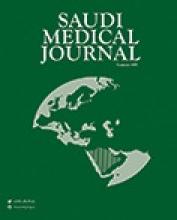Abstract
OBJECTIVE: The objective of this study is to evaluate the role of radiological examination in the management of adenoidal hypertrophy.
METHODS: A retrospective study was carried out in the North West Armed Forces Hospital, Tabuk, Kingdom of Saudia Arabia on pediatric patients who had x-ray of lateral naso pharynx to exclude adenoidal hypertrophy, January 2001 to December 2001. The study included; age of the patient, sex and reason for radiology examination and the management rendered.
RESULTS: A total of two hundred and ninety-seven pediatric patients were involved. Two hundred and thirteen males (71.7%) and 84 (28.3%) females, age ranged between 2 months and 12 years. The reason given for radiological examination was one or more of the following symptoms, snoring, mouth breathing, recurrent tonsillitis, runny nose, deafness and obstructive sleep apnea. Small adenoids reported in 63 patients (21.2%) and were treated for their complaints by their primary physician. Two hundred and thirty-four patients (78.8%) with large adenoids were referred to the otolaryngology department of these 33 patients lost follow up. One hundred and nineteen referred (40.1%) patients were treated conservatively, while 82 patients (27.6%) who showed resistance to medical treatment under went adenoidectomy with or without other related surgical procedures.
CONCLUSION: It was concluded that radiological examination in the management of adenoidal hypertrophy had a limited role, increased Radiological Department workload, wastage of resources in addition to unnecessary radiation exposure.
- Copyright: © Saudi Medical Journal
This is an open-access article distributed under the terms of the Creative Commons Attribution-Noncommercial-Share Alike 3.0 Unported, which permits unrestricted use, distribution, and reproduction in any medium, provided the original work is properly cited.






